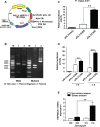Genetic polymorphism in Hsp90AA1 gene is associated with the thermotolerance in Chinese Holstein cows
- PMID: 29353403
- PMCID: PMC6045533
- DOI: 10.1007/s12192-017-0873-y
Genetic polymorphism in Hsp90AA1 gene is associated with the thermotolerance in Chinese Holstein cows
Abstract
The heat shock protein 90 (Hsp90) is a copious and ubiquitous molecular chaperone which plays an essential role in many cellular biological processes. The objective of this study was to identify single nucleotide polymorphisms (SNPs) in the Hsp90AA1 gene and to determine their association with heat stress traits in Chinese Holstein cattle breed. Direct sequencing was used to identify new SNPs. Luciferase reporter assay methods were used to assess g.- 87G > C and g.4172A > G loci in the promoter activity and 3'-UTR, respectively. Quantitative real-time PCR was utilized to quantify the gene expression profile. Five SNPs were identified in 130 multiparous lactating cows: one SNP in the promoter, three SNPs in the coding region, and one in 3'-UTR were novel and reported for the first time in this study. As a result of promoter assay using dual luciferase assay system, the genotype CC showed the highest transcription activity region (13.67 ± 0.578) compared to the wild-type GG (3.24 ± 0.103). On the other hand, the result revealed that one of the selected microRNAs (dme-miR-2279-5p) was found to interact with the Hsp90AA1 3'-UTR sequence and to suppress the reporter activity markedly in the presence of the allele G (2.480 ± 0.136). The expression of Hsp90AA1 in cow bearing mutant allele C was higher (4.18 ± 0.928) than cows bearing wild-type allele G (1.008 ± 0.0.129) in stress season. In summary, there was an association between genetic variations in the Hsp90AA1 and thermoresistance. This association could be used as a marker in genetic selection for heat tolerance in Chinese Holstein cattle breeds.
Keywords: Chinese Holstein cattle; Heat stress; Hsp90AA1 SNPs; Promoter activity; microRNA-mimic.
Figures







Similar articles
-
The HSP90AA1 gene is involved in heat stress responses and its functional genetic polymorphisms are associated with heat tolerance in Holstein cows.J Dairy Sci. 2024 Jul;107(7):5132-5149. doi: 10.3168/jds.2023-24007. Epub 2024 Feb 22. J Dairy Sci. 2024. PMID: 38395401
-
Cellular thermotolerance is associated with heat shock protein 70.1 genetic polymorphisms in Holstein lactating cows.Cell Stress Chaperones. 2011 Jul;16(4):441-8. doi: 10.1007/s12192-011-0257-7. Epub 2011 Jan 28. Cell Stress Chaperones. 2011. PMID: 21274669 Free PMC article.
-
Association analysis of HSP90AA1 polymorphism with thermotolerance in tropically adapted Indian crossbred cattle.Trop Anim Health Prod. 2024 Aug 3;56(7):230. doi: 10.1007/s11250-024-04055-2. Trop Anim Health Prod. 2024. PMID: 39096401
-
Regulation and function of the human HSP90AA1 gene.Gene. 2015 Oct 1;570(1):8-16. doi: 10.1016/j.gene.2015.06.018. Epub 2015 Jun 10. Gene. 2015. PMID: 26071189 Free PMC article. Review.
-
SNPs in microRNA target sites and their potential role in human disease.Open Biol. 2017 Apr;7(4):170019. doi: 10.1098/rsob.170019. Open Biol. 2017. PMID: 28381629 Free PMC article. Review.
Cited by
-
Genes and models for estimating genetic parameters for heat tolerance in dairy cattle.Front Genet. 2023 Feb 27;14:1127175. doi: 10.3389/fgene.2023.1127175. eCollection 2023. Front Genet. 2023. PMID: 36923799 Free PMC article. Review.
-
Identification and Functional Analysis of the Regulatory Elements in the pHSPA6 Promoter.Genes (Basel). 2022 Jan 21;13(2):189. doi: 10.3390/genes13020189. Genes (Basel). 2022. PMID: 35205234 Free PMC article.
-
Identification of single nucleotide polymorphisms (SNPs) potentially associated with residual feed intake in Qinchuan beef cattle by hypothalamus and duodenum RNA-Seq data.PeerJ. 2025 Apr 15;13:e19270. doi: 10.7717/peerj.19270. eCollection 2025. PeerJ. 2025. PMID: 40256725 Free PMC article.
-
2D antimonene-integrated composite nanomedicine for augmented low-temperature photonic tumor hyperthermia by reversing cell thermoresistance.Bioact Mater. 2021 Aug 19;10:295-305. doi: 10.1016/j.bioactmat.2021.08.018. eCollection 2022 Apr. Bioact Mater. 2021. PMID: 34901547 Free PMC article.
-
Association of selected gene polymorphisms with thermotolerance traits in cattle - A review.Anim Biosci. 2022 Nov;35(11):1635-1648. doi: 10.5713/ab.22.0055. Epub 2022 Jun 24. Anim Biosci. 2022. PMID: 35760402 Free PMC article.
References
-
- Bedulina D, Evgen'ev M, Timofeyev M, Protopopova M, Garbuz D, Pavlichenko V, Luckenbach T, Shatilina Z, Axenov-Gribanov D, Gurkov A. Expression patterns and organization of the hsp70 genes correlate with thermotolerance in two congener endemic amphipod species (Eulimnogammarus cyaneus and E. verrucosus) from Lake Baikal. Mol Ecol. 2013;22(5):1416–1430. doi: 10.1111/mec.12136. - DOI - PubMed
-
- Berry I, Shanklin M, Johnson H (1964) Dairy shelter design based on milk production decline as affected by temperature and humidity. Transactions of the ASAE 7: 329–331. doi:10.13031/2013.40772)@1964.
-
- Buffington D, Collazo-Arocho A, Canton G, Pitt D, Thatcher W, Collier R. Black globe-humidity index (BGHI) as comfort equation for dairy cows. Transactions of the ASAE. 1981;24(3):711–714. doi: 10.13031/2013.34325. - DOI
Publication types
MeSH terms
Substances
LinkOut - more resources
Full Text Sources
Other Literature Sources
Molecular Biology Databases
Research Materials
Miscellaneous

